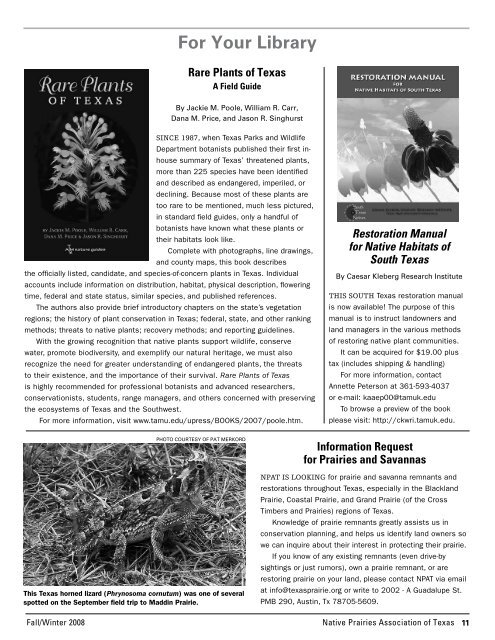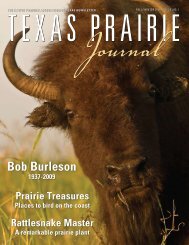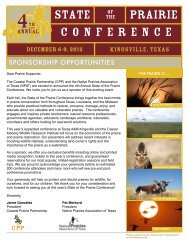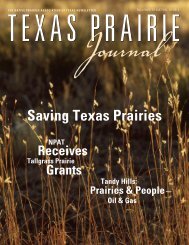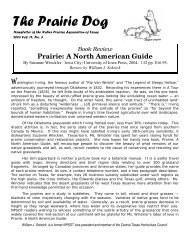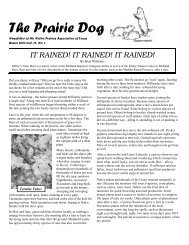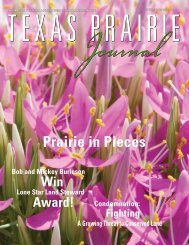Nash Prairie - Native Prairies Association of Texas
Nash Prairie - Native Prairies Association of Texas
Nash Prairie - Native Prairies Association of Texas
You also want an ePaper? Increase the reach of your titles
YUMPU automatically turns print PDFs into web optimized ePapers that Google loves.
For Your Library<br />
Rare Plants <strong>of</strong> <strong>Texas</strong><br />
A Field Guide<br />
By Jackie M. Poole, William R. Carr,<br />
Dana M. Price, and Jason R. Singhurst<br />
Since 1987, when <strong>Texas</strong> Parks and Wildlife<br />
Department botanists published their first inhouse<br />
summary <strong>of</strong> <strong>Texas</strong>’ threatened plants,<br />
more than 225 species have been identified<br />
and described as endangered, imperiled, or<br />
declining. Because most <strong>of</strong> these plants are<br />
too rare to be mentioned, much less pictured,<br />
in standard field guides, only a handful <strong>of</strong><br />
botanists have known what these plants or<br />
their habitats look like.<br />
Complete with photographs, line drawings,<br />
and county maps, this book describes<br />
the <strong>of</strong>ficially listed, candidate, and species-<strong>of</strong>-concern plants in <strong>Texas</strong>. Individual<br />
accounts include information on distribution, habitat, physical description, flowering<br />
time, federal and state status, similar species, and published references.<br />
The authors also provide brief introductory chapters on the state’s vegetation<br />
regions; the history <strong>of</strong> plant conservation in <strong>Texas</strong>; federal, state, and other ranking<br />
methods; threats to native plants; recovery methods; and reporting guidelines.<br />
With the growing recognition that native plants support wildlife, conserve<br />
water, promote biodiversity, and exemplify our natural heritage, we must also<br />
recognize the need for greater understanding <strong>of</strong> endangered plants, the threats<br />
to their existence, and the importance <strong>of</strong> their survival. Rare Plants <strong>of</strong> <strong>Texas</strong><br />
is highly recommended for pr<strong>of</strong>essional botanists and advanced researchers,<br />
conservationists, students, range managers, and others concerned with preserving<br />
the ecosystems <strong>of</strong> <strong>Texas</strong> and the Southwest.<br />
For more information, visit www.tamu.edu/upress/BOOKS/2007/poole.htm.<br />
Restoration Manual<br />
for <strong>Native</strong> Habitats <strong>of</strong><br />
South <strong>Texas</strong><br />
By Caesar Kleberg Research Institute<br />
This South <strong>Texas</strong> restoration manual<br />
is now available! The purpose <strong>of</strong> this<br />
manual is to instruct landowners and<br />
land managers in the various methods<br />
<strong>of</strong> restoring native plant communities.<br />
It can be acquired for $19.00 plus<br />
tax (includes shipping & handling)<br />
For more information, contact<br />
Annette Peterson at 361-593-4037<br />
or e-mail: kaaep00@tamuk.edu<br />
To browse a preview <strong>of</strong> the book<br />
please visit: http://ckwri.tamuk.edu.<br />
Photo courtesy <strong>of</strong> Pat Merkord<br />
This <strong>Texas</strong> horned lizard (Phrynosoma cornutum) was one <strong>of</strong> several<br />
spotted on the September field trip to Maddin <strong>Prairie</strong>.<br />
Information Request<br />
for <strong>Prairie</strong>s and Savannas<br />
NPAT is looking for prairie and savanna remnants and<br />
restora tions throughout <strong>Texas</strong>, especially in the Blackland<br />
<strong>Prairie</strong>, Coastal <strong>Prairie</strong>, and Grand <strong>Prairie</strong> (<strong>of</strong> the Cross<br />
Timbers and <strong>Prairie</strong>s) regions <strong>of</strong> <strong>Texas</strong>.<br />
Knowledge <strong>of</strong> prairie remnants greatly assists us in<br />
conser vation planning, and helps us identify land owners so<br />
we can inquire about their interest in protecting their prairie.<br />
If you know <strong>of</strong> any existing remnants (even drive-by<br />
sightings or just rumors), own a prairie remnant, or are<br />
restoring prairie on your land, please contact NPAT via email<br />
at info@texasprairie.org or write to 2002 - A Guadalupe St.<br />
PMB 290, Austin, Tx 78705-5609.<br />
Fall/Winter 2008<br />
native <strong>Prairie</strong>s <strong>Association</strong> <strong>of</strong> <strong>Texas</strong><br />
11


